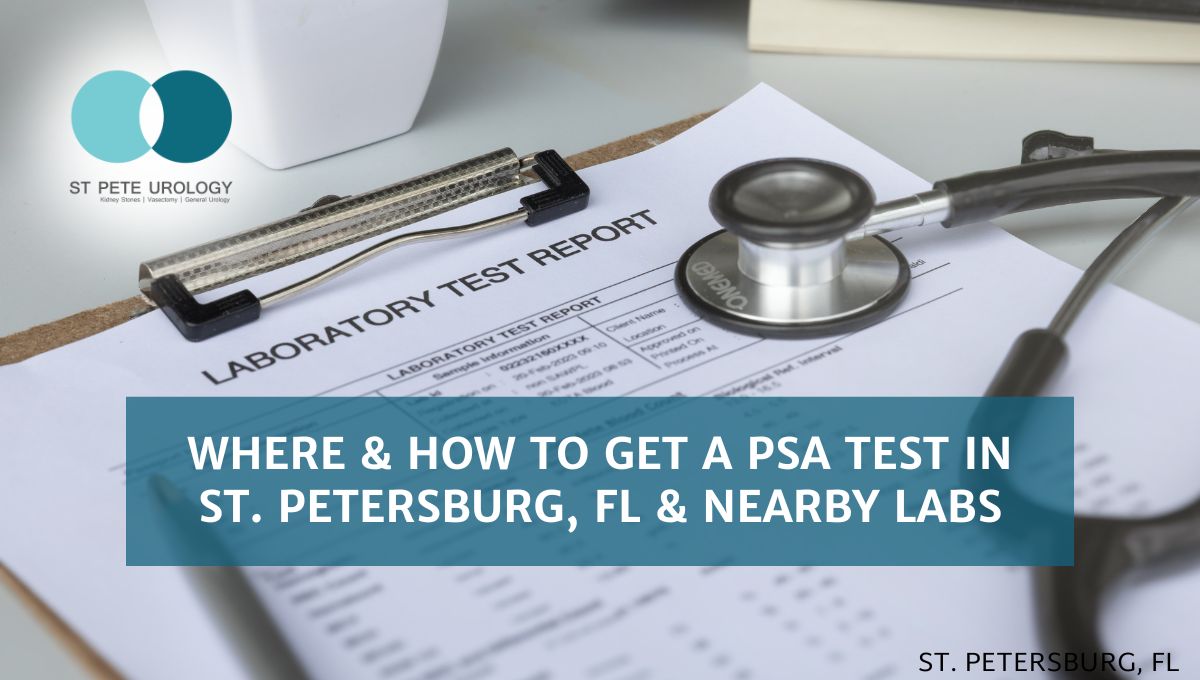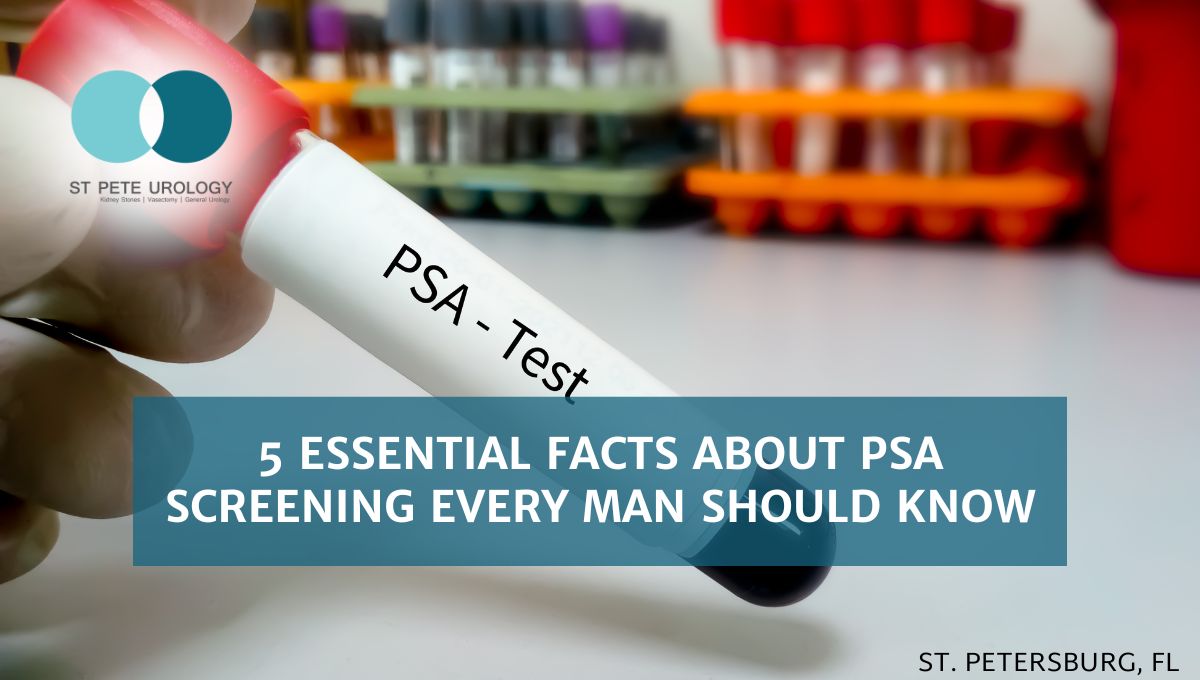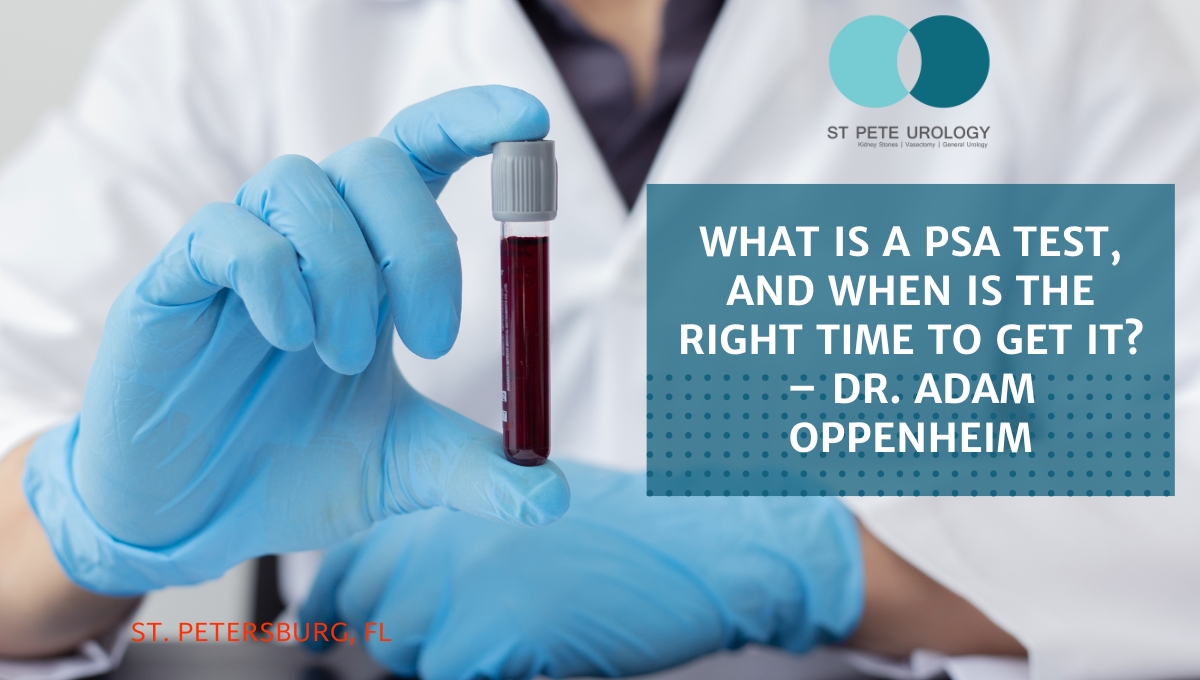Getting a PSA test in St. Petersburg is straightforward—multiple labs across the city offer same-day walk-ins, and direct-to-consumer options eliminate the need for a doctor’s visit.
Continue reading5 Essential Facts About PSA Screening Every Man Should Know
Understanding PSA screening guidelines is crucial for prostate health. Learn who needs testing, when to start, and what your PSA numbers mean for early cancer detection.
Continue readingWhat is a PSA Test, and When is the Right Time to Get It? – Dr. Adam Oppenheim
What is a PSA Test and When Should You Get It?
What are the benefits of the PSA test?
Early detection of certain types of prostate cancer is critical for successful treatment and recovery. When the PSA test shows elevated levels of the antigen in blood, it may help to identify prostate cancer that is likely to grow quickly or spread to other parts of the body. In turn, the test helps to catch and treat such cancers early before they begin causing serious symptoms or become life-threatening. Also, by enabling early detection of prostate cancer when the necessary treatment is less aggressive, the test reduces the risk of certain adverse effects of treatment, such as urinary incontinence and erectile dysfunction.
What are the risks associated with the PSA test?
Carrying out the test itself comes with very little risk. It requires only a simple drawing of blood used to run the test in a laboratory. However, once the results of the test are out, there are a number of potential downsides involved. For instance, since false positives are quite common and elevated PSA results may have other causes other than prostate cancer, including prostate infection (prostatitis) and enlarged prostate (BPH), the test results may expose some patients to unnecessary or inappropriate treatments.
Some types of prostate cancer don’t produce much PSA, which means that a test may incorrectly indicate that you don’t have the cancer (a false negative). And follow-up tests for checking out the underlying causes of an elevated PSA test are often stressful, invasive, time-consuming or expensive. Furthermore, living with a localized or slow-growing prostate cancer — one that doesn’t require treatment — can cause stress and anxiety.
When should you get your first PSA test?
Before you get the first PSA test, it is recommended that you discuss the benefits and risks of the test with your doctor. During the discussion, a comprehensive review of your risk factors and preferences is done. For example, the urologist will consider your age, race, size of your prostate, medications you are taking (dutasteride and finasteride affect PSA levels), and how frequently your PSA levels change when making a decision about getting the test.
At St. Pete Urology, we advise men who are at higher risk of the disease, such as African American men and those with a brother or father who have had the cancer, to get their first test at the age of 40-45. Having the test before you reach 50 helps us to establish your PSA baseline and thereafter monitor the changes in your PSA levels to determine whether or not you’ll need annual PSA screening and prostate biopsy. If your blood PSA level is very low, we’ll put off any further PSA tests. But if you are a man of moderate to low risk of the disease, we recommend you get your first PSA test at age 50 or older (generally between 55 and 70).
What happens if your first PSA test result is high?
If you don’t have symptoms of prostate cancer, another PSA test may be recommended if your first test showed an elevated PSA level. The second test is used to confirm the validity of the original finding. But if the second PSA test still gives elevated PSA level, the urologist may direct that you continue with more PSA blood tests and digital rectal exams (DREs) at frequent intervals to monitor any changes in your prostate over time.
If your blood PSA level continues to rise over time or the urologist finds a suspicious lump in your prostate during a DRE, additional tests may be suggested to establish the nature of the problem. For example, a urine test may be run to find out if you have a UTI (urinary tract infection). Imaging tests like X-rays, cystoscopy or transrectal ultrasound also may be recommended. Then if prostate cancer is suspected, the urologist carries out a prostate biopsy — collecting multiple samples of tissue from your prostate by inserting hollow needles into the gland and withdrawing tissue. The tissues are examined under a microscope by a pathologist to confirm the cancer.
Treatment of prostate cancer
The type of treatment recommended for prostate cancer usually depends on whether it is early-stage or advanced-stage disease. For early-stage cancer the options include watchful waiting, radical prostatectomy, brachytherapy, conformal radiotherapy and intensity-modulated radiation therapy. At St Pete Urology, watchful waiting means no immediate treatment is offered but the cancer is closely monitored through regular PSA tests. Prostatectomy involves surgically removing part of or the entire prostate; brachytherapy involves implantation of radioactive seeds into the prostate to deliver specific amounts of radiation to the tumor. Conformal and intensity modulated radiotherapies deliver targeted amounts of radiation to the tumor with minimal damage or exposure of healthy tissues.
For advanced-stage prostate cancer, which is typically a more aggressive tumor that grows quickly and spreads faster to other areas of the body, treatment includes chemotherapy and androgen deprivation therapy. Chemotherapy can eliminate cancer cells that have spread to other parts of the body. Likewise, androgen deprivation therapy (androgen suppression therapy or ADT) is used to reduce the effect of androgens — male hormones that stimulate cancer growth — thereby slowing down or stopping cancer growth.
At St Pete Urology, we talk to our patients openly and candidly about the risks and benefits of the PSA test before we can advise them to get it. We also discuss the results of the tests, give our recommendations for those with positive results and typically repeat the PSA test for those with negative results. Our patients have always told us that our attention to detail, quality of interactions and efficiency during their visits is unmatched. If you would like to know more about the PSA test, visit the “St Pete Urology” site.
2 Effective Screening Tests for Prostate Cancer
Even though prostate cancer typically grows very slowly or not at all, it is still advisable to start screening early before the symptoms appear. Early prostate cancer screening may help to discover any aggressive type of the cancer and ensure prompt treatment. Today, there two most effective and recommended tests for screening are prostate specific antigen (PSA) test and digital rectal exam (DRE).
PSA
All contemporary recommendations for prostate cancer screening incorporate the prostate specific antigen (PSA) levels in serum because there is convincing evidence that PSA-based screening detects many cases of asymptomatic prostate cancer. Studies also have shown that a vast majority of men who have asymptomatic cancer detected through the PSA test have tumors that either will fail to progress or will grow so slowly that they would have shown no symptoms for the patient’s lifetime. If your PSA level is high, your urologist will recommend either waiting for a period and then repeating the test or doing a prostate biopsy to confirm if you have the cancer. When interpreting your PSA results, your urologist will consider many factors, such as race, age and family history.
Digital Rectal Exam (DRE)
During DRE, the urologist inserts a gloved, lubricated finger into the rectum to feel for any hard areas or bumps on the prostate, which might indicate cancer. The exam may be slightly uncomfortable, but is never painful and just takes a short time. While the digital rectal exam may be less effective than the PSA in detecting prostate cancer, it sometimes can detect cancer in men with normal PSA levels. For this reason it is a critical component of prostate cancer screening.
What next after screening?
PSA and DRE tests are simply used to detect the warning signs of prostate cancer, but in reality they do not actually confirm if you have cancer. If the test results are abnormal, your urologist will use a prostate biopsy for confirmation. If there is cancer, a prostate biopsy also will help determine the aggressiveness and influence the urologist’s decision as to whether or not you need treatment. Not every patient must be treated and those with non-aggressive cancer will just be actively monitored. The decision on whether you get treated is very important and is usually based on results of these tests. For more information on early prostate cancer diagnosis and treatment, visit the site, St Pete urology.
When Should You Get A PSA Test?
When should you take the Prostate-Specific Antigen (PSA) test? The question of screening is typically a personal and complex issue that requires a consultation with a urologist. Currently, the medical community does not share a unanimous opinion regarding the benefits of prostate cancer screening.
Most physician-led groups, like the American Urological Association and the American Society of Clinical Oncology, insist that PSA screening ought to be considered within the context of a man’s life expectancy and level of risk given other prior or existing medical conditions. Other groups have advised that PSA screening for healthy men under 40 comes with a risk of harm that may outweigh the benefits depending on the patient’s medical history.
When should you start screening?
The decision on when to start screening should depend on your overall health, level of risk, life expectancy, and desire for treatment should you be diagnosed with prostate cancer. While the time to start screening depends on individual factors, the age of 40 years is a reasonable time to begin, particularly for those with genetic predispositions or a family history of cancer. Likewise, for healthy men at high risk, such as African American men with a family history of prostate cancer, starting at age 40 is advisable.
For men at average risk, a urologist may recommend the initial DRE or PSA test at age 40 or 45, while some urologists may recommend starting at age 50. In general, most men have discussed PSA testing with their doctor by the time they reach age 50. This means that men above 40 years should consider discussing PSA screening with their urologist to determine if and when the test is right for them. All men should develop a proactive prostate health plan based on their family history and lifestyle.
When should you visit a urologist?
The above recommendations are specific to prostate cancer screening for healthy men showing no symptoms. If you are diagnosed with prostate cancer and a confirmation is made using a biopsy, your urologist may recommend routine PSA testing for risk assessment and post-treatment monitoring.
The right time to start PSA screening is an individual decision that depends on your risk level and family history. Visit your urologist to discuss the timing of this important medical test for men. For more information on the screening and treatment of prostate cancer, visit St Pete Urology in St Petersburg, Florida.
The Prostate Cancer Test That Saved My Life
“Yeah,” he said, in a slightly nonplussed way, gazing at the results, “I was surprised myself.”
As my new, world-altering doctor spoke about cell cores and Gleason scores, probabilities of survival, incontinence and impotence, why surgery would be good and what kind would make the most sense, his voice literally faded out like every movie or TV show about a guy being told he had cancer… a classic Walter White moment, except I was me, and no one was filming anything at all.
 I got diagnosed with prostate cancer Friday, June 13th, 2014. On September 17th of that year I got a test back telling me I was cancer free. The three months in between were a crazy roller coaster ride with which about 180,000 men a year in America can identify.
I got diagnosed with prostate cancer Friday, June 13th, 2014. On September 17th of that year I got a test back telling me I was cancer free. The three months in between were a crazy roller coaster ride with which about 180,000 men a year in America can identify.
Right after I got the news, still trying to process the key words echoing dimly in my head (probability of survival–vival-vival-val…” “incontinence-nence-nence-ence …), I promptly got on my computer and Googled “Men who had prostate cancer.” I had no idea what to do and needed to see some proof this was not the end of the world.
John Kerry… Joe Torre… excellent, both still going strong. Mandy Patinkin… Robert DeNiro. They’re vital. OK great. Feeling relatively optimistic, I then of course had to do one more search, going dark and quickly tapping in “died of” in place of “had” in the search window.
As I learned more about my disease (one of the key learnings is not to Google “people who died of prostate cancer” immediately after being diagnosed with prostate cancer), I was able to wrap my head around the fact that I was incredibly fortunate. Fortunate because my cancer was detected early enough to treat. And also because my internist gave me a test he didn’t have to.
Taking the PSA test saved my life. Literally. That’s why I am writing this now. There has been a lot of controversy over the test in the last few years. Articles and op-eds on whether it is safe, studies that seem to be interpreted in many different ways, and debates about whether men should take it all. I am not offering a scientific point of view here, just a personal one, based on my experience. The bottom line for me: I was lucky enough to have a doctor who gave me what they call a “baseline” PSA test when I was about 46. I have no history of prostate cancer in my family and I am not in the high-risk group, being neither — to the best of my knowledge — of African or Scandinavian ancestry. I had no symptoms.
What I had — and I’m healthy today because of it — was a thoughtful internist who felt like I was around the age to start checking my PSA level, and discussed it with me.
If he had waited, as the American Cancer Society recommends, until I was 50, I would not have known I had a growing tumor until two years after I got treated. If he had followed the US Preventive Services Task Force guidelines, I would have never gotten tested at all, and not have known I had cancer until it was way too late to treat successfully.
Now, in my case, my doctor, Bernard Kruger, watched my PSA tests rise for over a year and a half, testing me every six months. As the numbers continued to rise, he sent me to the urologist, who gave me a slightly invasive physical check in his office using a gloved finger. This took all of 10 seconds. While I don’t recommend it for fun, amazingly some don’t recommend it at all. After this exam, and looking at my rising PSA numbers, he suggested an MRI to get a roadmap of my prostate.
It’s a non-invasive procedure like the one athletes get to check for torn ACLs. Loud, but painless. Only after studying the MRI results did my doctor recommend a not-fun-at-all biopsy. Unlike the MRI, the biopsy was as invasive as it gets: long needles in sensitive places and more small talk about kids and school pick ups while it was all going down.
Then the biopsy came back positive. Of course “positive” for medical tests is usually not so positive. I had a Gleason score of 7 (3+4), which is categorized “mid-range aggressive cancer.” Surgery was recommended. At this point I decided to go out and get a few different opinions. All the doctors I talked to concurred that the tumor needed to be taken out.
Ultimately, I found a wonderful surgeon named Edward Schaeffer who I felt comfortable with. He performed a robotic assisted laparoscopic radical prostatectomy. Due to a lot of skill and a little beneficence from some higher power, he got all the cancer. As of this writing I am two years cancer free and extremely grateful.
So. What is the deal with this PSA test and why the controversy?
It is a simple, painless blood test. It is not dangerous in itself in any way. If the PSA (Prostate Specific Antigen) value is elevated in the blood, or levels rise sharply over time, it could indicate the presence of prostate cancer. It is definitely not foolproof.
The criticism of the test is that depending on how they interpret the data, doctors can send patients for further tests like the MRI and the more invasive biopsy, when not needed. Physicians can find low-risk cancers that are not life threatening, especially to older patients. In some cases, men with this type of cancer get “over-treatment” like radiation or surgery, resulting in side effects such as impotence or incontinence. Obviously this is not good; however it’s all in the purview of the doctor treating the patient.
But without this PSA test itself, or any screening procedure at all, how are doctors going to detect asymptomatic cases like mine, before the cancer has spread and metastasized throughout one’s body rendering it incurable? Or what about the men who are most at risk, those of African ancestry, and men who have a history of prostate cancer in their family? Should we, as the USPSTF suggests, not screen them at all? There is growing evidence that these guidelines have led to increased cases of prostate cancers that get detected too late for the patient to survive the disease.
Five years after their initial recommendation to stop PSA testing, the USPSTF is presently, per their website, “updating their recommendations.” I think men over the age of 40 should have the opportunity to discuss the test with their doctor and learn about it, so they can have the chance to be screened. After that an informed patient can make responsible choices as to how to proceed.
I count my blessings that I had a doctor who presented me with these options. After I chose to take the test, he directed me to doctors who worked at centers of excellence in this field to determine the next steps. This is a complicated issue, and an evolving one. But in this imperfect world, I believe the best way to determine a course of action for the most treatable, yet deadly cancer, is to detect it early.
Learn How to Prevent Prostate Cancer
Prostate Cancer affects only men and especially men over the age of 60. There are certain factors that increase the risk of Prostate Cancer. They include smoking and drinking alcohol. Discontinuing these habits early enough can often prevent the disease from occurring. To learn more about How to Prevent Prostate Cancer, call St Pete Urology at (727) 478-1172.





